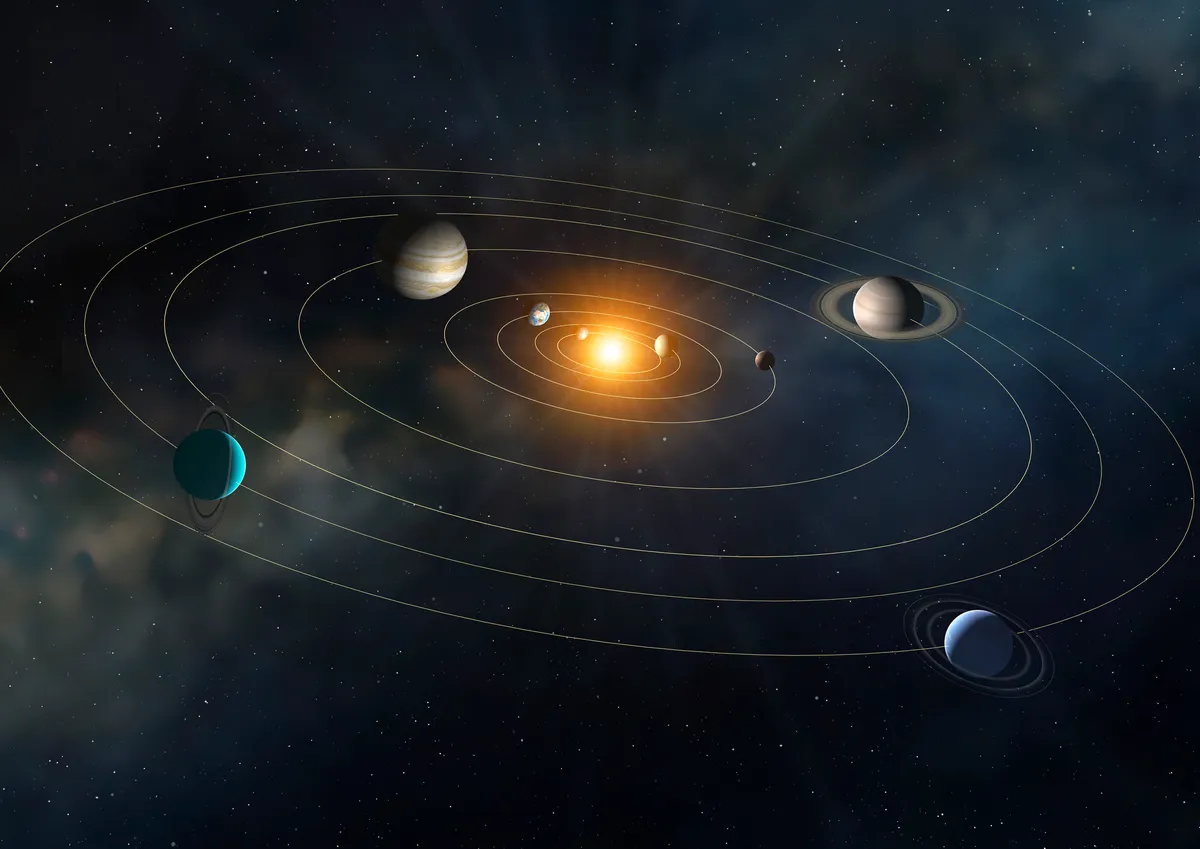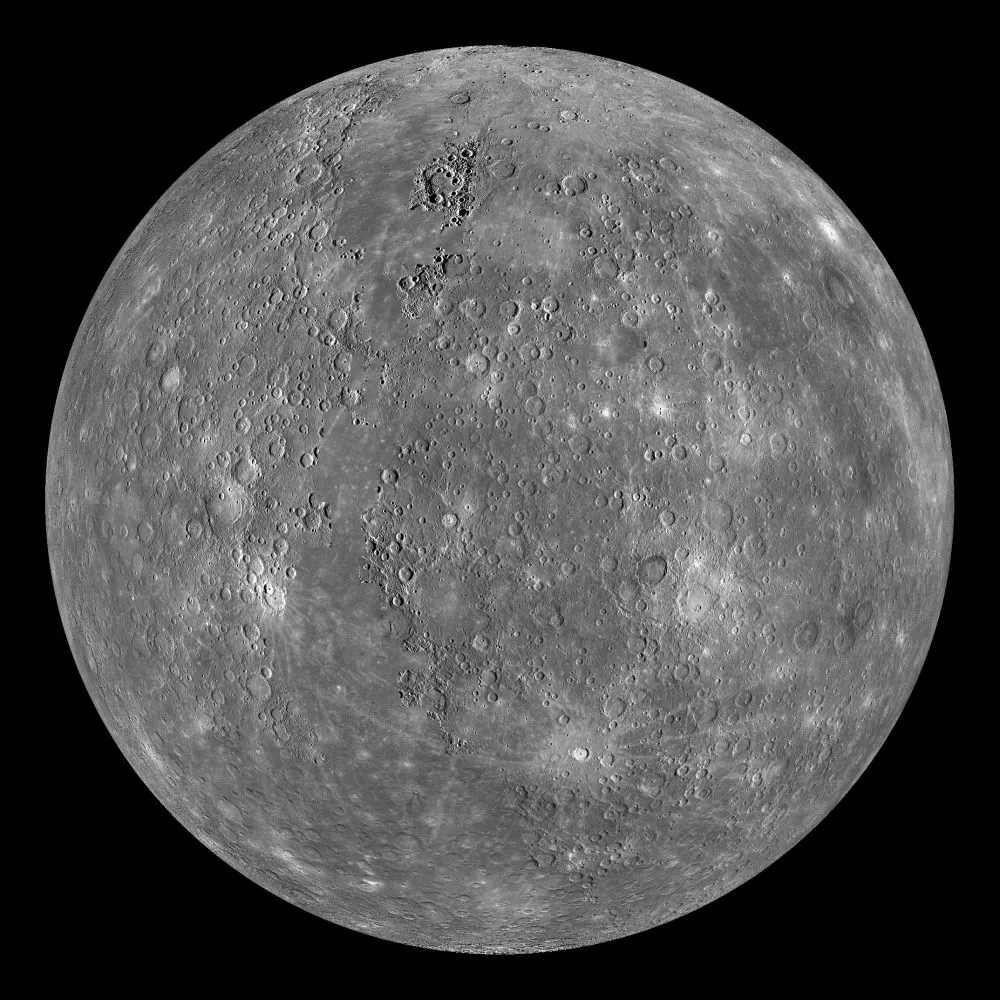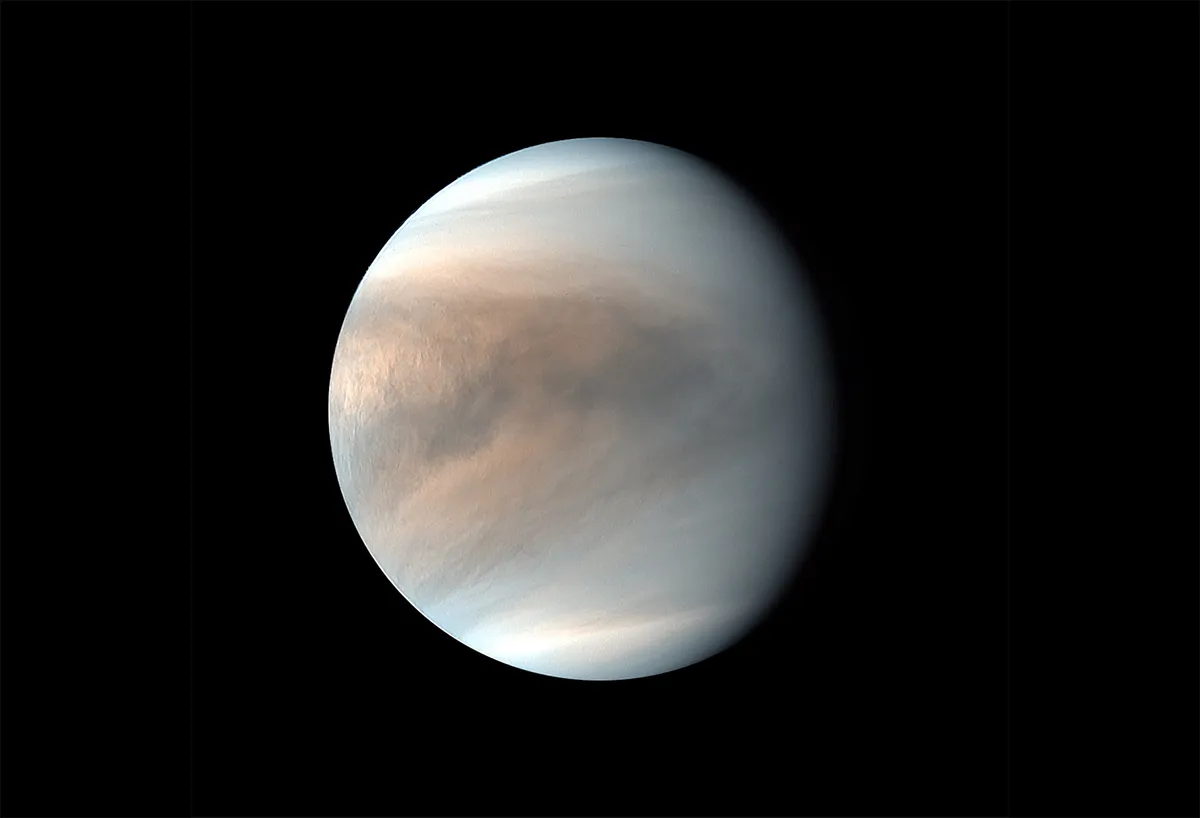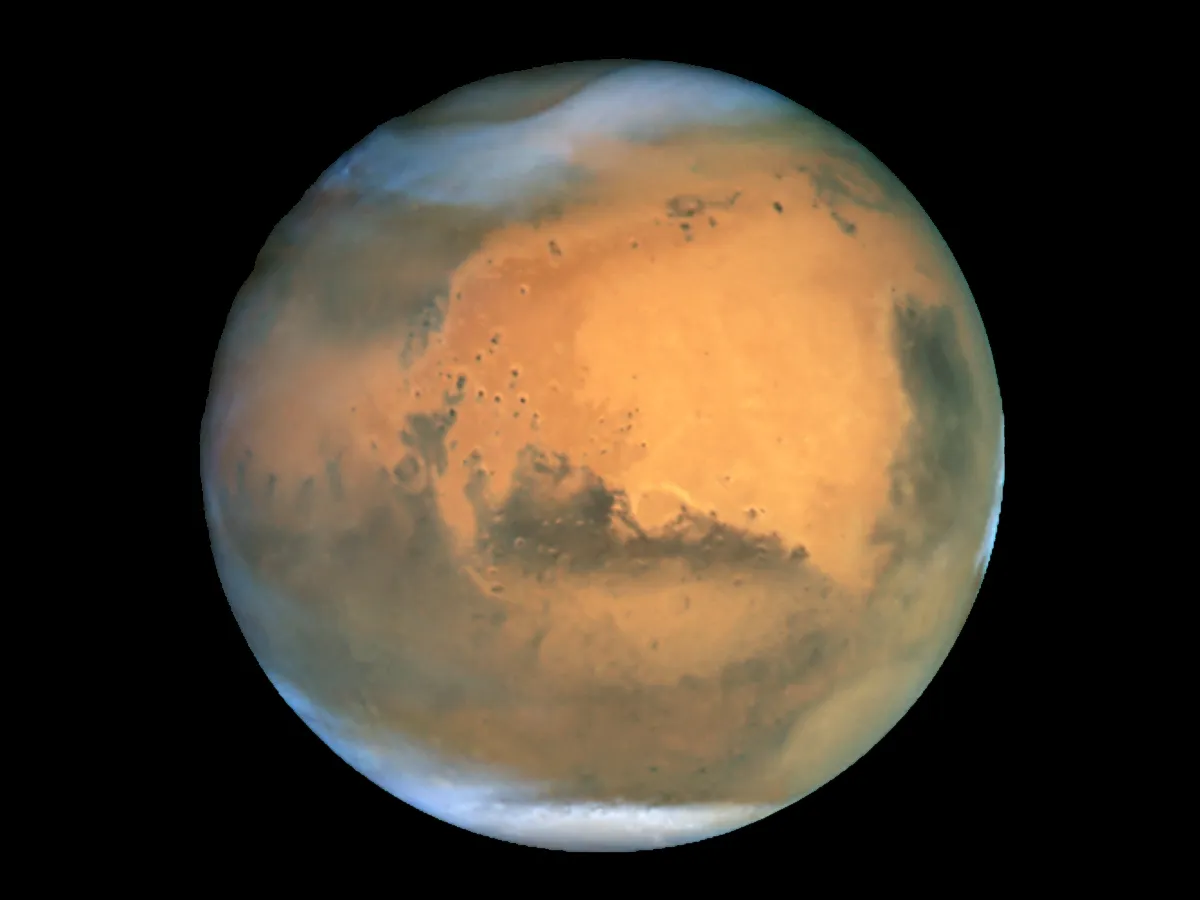The Solar System is our cosmic neighbourhood: 8 planets and numerous other planetary bodies and moons orbiting the Sun to create a fascinating variety of rocky planets, cratered moons, gas giants and salty oceans lurking beneath frozen crusts.
Currently there are 8 planets and 5 dwarf planets recognised in our Solar System.

All the planets move in the same anticlockwise direction around the Sun, if we take Earth’s north pole as an arbitrary reference of ‘up’.
The Sun’s gravity ‘well’ is immense. Imagine a great bowling ball creating a dip in a trampoline.
The planets are like marbles rolling along inside this dip around the bowling ball Sun.
In this guide we'll look at each of the planets of the Solar System, and also list them in order of distance from the Sun as well as in order of size.

Order of planets by distance from the Sun
Distance measured in astronomical units, where 1 AU = average distance between Earth and the Sun
- Mercury (0.39 AU)
- Venus (0.72 AU)
- Earth (1 AU)
- Mars (1.5 AU)
- Jupiter (5.2 AU)
- Saturn (9.54 AU)
- Uranus (19.2 AU)
- Neptune (30 AU)
Order of planets by size
Sizes listed as equatorial diameter. Jupiter is the Solar System's largest planet; Mercury is the smallest.
- Jupiter 88,846 miles (142,984km)
- Saturn 74,898 miles (120,536km)
- Uranus 31,763 miles (51,118km)
- Neptune 30,775 miles (49,528km)
- Earth 7,926 miles (12,756km)
- Venus 7,521 miles (12,104km)
- Mars 4,221 miles (6,792km)
- Mercury 3,032 miles (4,880km)
Remembering the order of the planets
There are numerous ways to remember the order of the planets by creating a sentence – however nonsensical – out of the letters at the start of each planet's name.
These are known as mnemonics.
Older mnemonics for remembering the order of the planets include Pluto, which was reclassified as a dwarf planet in 2006.
Methods for remembering 9 planets include:
My Very Easy Method Just Speeds Up Naming Planets
My Very Educated Mother Just Served Us Nine Pizzas
Methods for remembering 8 planets include:
My Very Easy Method Just Speeds Up Nothing
My Very Educated Mother Just Served Us Noodles
However, given that many planetary mnemonics are effectively a random selection of words that happen to follow the syntactical rules for building a sentence in English, you could find it just as easy (and inherently more useful) remembering the order of the planets by remembering the order of the planets!
Mercury, Venus, Earth, Mars, Jupiter, Saturn, Uranus and Neptune.

The closer the planets are to the Sun, the stronger that planet's pull of gravity and the faster it has to move to keep from being pulled into solar destruction.
All this speed, or lack of it, affects how a planet moves across the night sky as seen from Earth’s surface.
Whereas Saturn crawls around the sky, barely moving among the stars, Mercury’s fast pace means it shifts considerably day by day.
This is what the gravity of the Sun does, but there’s also its light to consider. We only see the planets because the Sun lights them up.
Their brightness is due to many things, including their actual distance from the Sun, the distance they are from your eye, and their size, composition and colour.
Below we'll reveal how the planets of the Solar System formed, the characteristics that define them as the worlds we know today, and also how to see them in the night sky for yourself.

But first, a word about the former 9th planet of the Solar System and why Pluto is not a planet.
Pluto lost its planetary status in 2006, after other similar (and some larger) objects were found where it orbits in the Kuiper Belt on the edge of the Solar System.
These bodies are known as trans-Neptunian objects or Kuiper Belt Objects, and, according to the International Astronomical Union at least, Pluto is among them.
To meet today’s definition of a planet, as well as being rounded by its own gravity and in orbit round the Sun, a body has to have cleared its orbit of other objects its size, which Pluto isn't deemed to have done.
As a result, Pluto is now considered a dwarf planet.

How the Solar System formed
5 billion years ago, something was stirring out in space: a huge cloud of hydrogen and helium was collapsing.
The gas rushed towards the centre of the mass, fusing together until it burst into life as the star that we now know as the Sun.
As the Sun was forming, so were the planets. Before our star was born, another, larger one had died in a supernova, filling the cloud with gas and dust.
This debris gradually formed a protoplanetary disk – a huge, flat ring comprising hundreds of lumps of rock and ice known as planetesimals.

These planetesimals were the building blocks of the Solar System. After a few million years of crashing and melding together, these bodies began to resemble the planets as we know them today.
Close to the Sun, temperatures were too high for volatile chemicals such as water to remain solid in any quantities.
The initial protoplanetary disk contained only a small amount of rocky solid material, so the four planets that formed closest to the Sun were comparatively small.
However, 750 million kilometres from the Earth at what is now the outer edge of the asteroid belt, temperatures were cool enough for gases to form thick atmospheres around rocky cores, creating the gas giants Jupiter, Saturn, Uranus and Neptune.
It wasn’t just planets forming, though: several moons did, too. Though many moons are former planetesimals that were captured by a planet, a few – including our own – had a much more violent beginning.

When the infant Earth collided with another young planet, a huge plume of debris was trailed behind. After a few hundred million years it melded together to create our planet’s largest companion: the Moon.
By four billion years ago the planets and moons had been formed, but the Solar System still looked very different from its current state.
There were probably many more planets than the eight we know today, and they would have been much closer together.
Over time the outer planets began to move slowly away from the Sun, throwing the gravitational forces of the Solar System off balance.

The result was that several early planets were thrown out into deep space and, around four billion years ago, the remaining debris was pelted against the planets.
This period, now known as the Late Heavy Bombardment, left scars that can still be seen on the faces of the Moon, Mars and other rocky planets.
On Earth, such craters have been hidden by the actions of volcanism or worn away by the atmosphere.
The most significant relic left on our planet from that bombardment is the array of elements left behind.
During Earth’s formation, metals such as gold and copper sank to the core, so the deposits we find in the crust today must have arrived on asteroids and comets at a later date.
Perhaps the most important delivery to our planet was water.
The early Solar System was far too hot for water to settle but, by the time of the Late Heavy Bombardment, temperatures had dropped significantly.

When comets crashed into the surface of the early planets, water didn’t boil off immediately but instead formed oceans.
After hundreds of millions of years, the planets had settled into their orbits and began to grow and evolve. Volcanism shaped their surfaces while, deep inside, molten cores began to cool.
The cores of the smaller terrestrial planets solidified; without the flow of metallic cores, their protective magnetic fields faded, leaving their atmospheres unshielded from solar winds.
As time progressed, such differences between each world became exaggerated, leading to the variation in planets that we see in the Solar System today.
And the process is far from over. Comets and asteroids still pelt the planets, and the Sun is slowly expanding and becoming brighter. In another few billion years the Solar System will have transformed itself once again.
Inferior planets

Because Mercury and Venus are closer to the Sun than Earth, they are known as the inferior planets.
The best time to observe them is when they are at their farthest angular distance from the Sun, a position astronomers call elongation.
At these times, the planets are only half lit by the Sun, but after this they swing back into the solar glare, where they become less visible.
When Mercury and Venus are at eastern elongation, they set after the Sun in the evening; at western elongation they rise before the Sun in the morning.
The Sun interferes with our views of the inferior planets twice during their orbits: when they all line up, the two points being known as inferior and superior conjunction.
Superior planets

The planets further out from Earth - Jupiter, Saturn, Uranus and Neptune - are called superior planets.
These don’t present the same problems for observers as Mercury and Venus in that they can be visible all night long.
When any of them line up with Earth on the far side of the Sun, it is said to be in conjunction. The best time to observe the superior planets is when they are close to Earth.
This happens at opposition, when the planet is on theopposite side of the sky to the Sun,so we are presented with a fully illuminated disc: visually it’s close to orat its biggestand brightest.
Facts about each planet of the Solar System
Mercury

- Diameter: 4,880km
- Moons: 0
- Distance from Sun: 58 million km
Mercury is so close to the Sun that its year is a mere 88 days long. The orbit of the smallest planet – only a little larger than our Moon – is highly eccentric, meaning that its distance from our star varies between 45.8 to 70 million kilometres over its year.
The innermost planet is a world of contradictions. Its proximity to the Sun has resulted in the planet’s rotation being near-locked: it spins so slowly that its days are twice as long as its years – so from one sunrise to the next, Mercury will have orbited the Sun twice.
The long days and nights cause the climate of the planet to swing between extremes. During Mercury’s day the Sun’s heat roasts the surface seven times more fiercely than it does on Earth, raising the temperature to over 420°C.
That intense heat and radiation long ago blasted away any vestiges of atmosphere: with no gases to help trap heat near the planet’s surface, when night falls the temperature drops to as low as –180°C.

How to observe Mercury
This small planet is a real challenge to observe for a variety of reasons. It’s a fast mover, travelling around the Sun four times more quickly than Earth, so don’t expect it to hang about in any part of the sky for very long.
Mercury’s orbit is a fairly eccentric oval shape, and it’s on a bit of a tilt too, which means some times are better for viewing it than others: spring evenings and autumn mornings.
If that’s not tricky enough, you only have a relatively short observation window on any day you choose to look, as Mercury never strays very far from the Sun.
In spring, start looking 30 minutes after sunset, after which you’ll have about another 45 minutes to see it. Autumn gives you a longer view, from about an hour and 45 minutes before sunrise, but that does mean getting up exceedingly early.
Venus

- Diameter: 12,100km
- Moons:0
- Distance from Sun:108 million km
Despite being named for the Roman goddess of love, the planet Venus is anything but romantic. Just 45 million kilometres from our planet’s orbit, and with a mass 80% that of Earth’s, Venus is our nearest neighbour in terms of both distance and size – yet our two worlds are vastly different.
The atmosphere of Venus is the densest of any of the terrestrial planets – air pressure at its surface is 92 times that on Earth.
It is also highly toxic, composed of 96% carbon dioxide. Such a high concentration of greenhouse gases caused a dramatic build-up of heat: temperatures at the surface can reach 462°C.
Thick clouds mask the terrain below but we do have a few images of the surface of Venus – the first taken on another planet – from Soviet Venera probes.
It seems Venus was once not so different from Earth, and may even have had oceans before its deadly atmosphere created the desolate world we see today.
There have been numerous missions that have tried to gather as much information about Venus as possible, given its hellish conditions, including the Venus Express probe.
In 2020, astronomers announced the presence of phosphine on Venus, which could indicate evidence of microbial life.

How to observe Venus
Because Venus’s orbit is slower than Mercury’s, it can be visible for months on end, and sometimes for up to three hours after sunset or before sunrise.
When Venus is at its brightest, it becomes the third-brightest object in the sky, only beaten by the Moon and the Sun.
This is caused by sunlight reflecting off its bright white carbon-dioxide clouds, and has led to Venus being called the ‘Evening Star’ or ‘Morning Star’ depending on when it appears.
Venus can come very close to Earth, plus it’s rather big, meaning that it’s a good target for binoculars, through which you can easily see its larger phases.
There are a few neat photography and observing challenges relating to Venus, including photographing the ring of Venus, seeing if you can decipher the mystery of Venus's ashen light and capturing a shadow cast by the light of Venus.
Earth

- Diameter: 12,700km
- Moons: 1
- Distance from the Sun: 150,000,000km
While the rest of the Solar System is populated by worlds of extremes, Earth maintains a perfect balance.
Not too close to the Sun to boil, not so far away that its water all freezes, it remains at just the right temperature to preserve the oceans that have helped shape our world.
Indeed, our liquid water has been preserved for over four billion years, thanks to the atmosphere and magnetic field that protect us from harsh solar winds.

Perhaps our world’s most striking feature is its Moon. Created by a colossal crash between a Mars-sized planetoid and the proto-Earth, ours is the largest natural satellite in the Solar System relative to its planet’s size.
The two bodies have a huge affect on each other. The Moon’s pull on our oceans creates the tides, and our planet’s pull has gradually reduced the Moon’s momentum so that its rotation is locked – which is why we always see the same side of the Moon.
Mars

- Diameter: 6,800km
- Moons: 2
- Distance from Sun: 228 million km
With a diameter half that of Earth, Mars is the Solar System’s second smallest planet, but is probably the one that has most captured the human imagination.
Until Mariner 4 sent back the first close-up images of Mars in the 1960s and Mariner 9 did the same in the 1970s, many believed it might harbour life. Indeed, it's interesting to consider what astronomers used to believe about Mars.
A few billion years ago, Mars probably didn’t look that different from our own planet.
Only another 75 million kilometres farther away from the Sun than the Earth, it was warm enough to maintain liquid oceans on most of the surface and its short day of 24 hours and 40 minutes helped to keep the temperature constant across the planet’s surface.
Now things are very different. At some point the planet was stripped of its atmosphere and, with it, most of the water. Though some remains frozen into the soil, this is now a barren, dead landscape.
However, many believe that, in its more pleasant days, Mars might once have been home to more than rocks and dust. Dozens of missions have been sent to the planet, hoping to find signs of life on Mars.

How to observe Mars
Mars differs from Mercury and Venus in that its position in the Solar System – on the other side of Earth – means it can be ‘up’ from sunset until sunrise.
A small telescope can reveal lighter, pale-reddish areas, the bright white of the ice caps, and darker patches, which it used to be thought were Martian ‘cities’.
Jupiter

- Diameter: 143,000km
- Moons: 67
- Distance from Sun: 778 million km
The largest planet in the Solar System, Jupiter has more mass than all of the other planets put together and is second only to the Sun in terms of gravitational power.
Jupiter is the first of the gas giants – and the most spectacular. It is large enough to house the rest of the Solar System’s planets twice over.
With a mass 318 times that of the Earth, Jupiter’s gravitational pull affects all of the planets and bodies in the Solar System.
During the system’s formation, Jupiter played a pivotal role by sucking up material that could have gone on to form other planets.

Despite its size, Jupiter is the planet with the shortest day, taking less than 10 hours to complete one rotation.
However, measuring the day’s length has been a challenge; being a gas giant, it doesn’t have a solid surface with static features we can track. Instead, Jupiter is composed of many layers of gases that move independently.
The only layer we can see is the upper 50 km, a huge swirl of currents that is home to Jupiter’s best-known feature, the Great Red Spot, a storm the size of the Earth that’s been raging for centuries.
In 1994 it enticed comet Shoemaker-Levy 9 to fragment and crash into its swirling clouds; other likely comet crashes were recorded in 2009 and 2010. Jupiter is mostly gas, its composition of hydrogen and helium similar to that of the Sun.

How to observe Jupiter
With a good pair of binoculars the first things you’ll notice are its four most famous moons: Io, Europa, Ganymede and Callisto, spied by Galileo Galilei in 1610 and so known as the Galilean moons.
With a telescope you’ll see a slightly squashed sphere. This is due to its fast spinning ‘day’ of just under 10 hours, which causes the equator to bulge outwards and the poles to flatten (for more on this, watch our video demonstrating how spinning changes the shape of planets).
Jupiter’s cloudy atmosphere will be revealed as dark bands separated by white zones. The longer you look, the more features appear, so keep an eye out for spots, wisps and kinks.
The most famous feature is, of course, the Great Red Spot, a storm that changes shape, size and colour over time, often appearing quite greyish.
Saturn

- Diameter: 120,500km
- Moons: 146
- Distance from Sun: 1.43 billion km
The sixth planet, Saturn, is also the second largest – at 760 times bigger than Earth, and 9.5 times farther away from the Sun, it is the most distant world that can be seen with the naked eye.
Almost entirely hydrogen, it is so light that – if you could find a swimming pool big enough to test the theory – the entire planet would float in water.
Saturn is also the planet with the most moons in the Solar System, having even more than Jupiter and making it the king of the moons.
Saturn's rings are its most famous feature. Almost pure water ice, the nine main rings extend to 80,000km above the surface of the planet that is itself 120,500km in diameter. Surprisingly, they are only 1km thick.
The gravity of 146 moons helps to shepherd the ice into defined orbits, leading to the intricate patterning of the rings.
How exactly the rings were created is still a mystery. Some theories suggest that they comprise material left over from the planet’s formation, others that they are the shattered remains of a moon.
It’s uncertain if the rings are even a permanent fixture or merely a passing feature that we are lucky enough to glimpse.

How to observe Saturn
Like all the outer planets, Saturn opposition is the best time to observe the ringed giant.
Saturn’s brightness varies due to the way the rings are tilted and how much sunlight they reflect.
The planet is not so bright when the rings are edge-on to us, but its brightness increases over 7.5 years as the rings open up to observers on Earth.
Then it fades again over the same period. If you’re wondering why this takes 7.5 years, it’s a quarter of the time Saturn takes to go around the Sun.
The best way of understanding Saturn’s tilting effect is to go out and look at the planet – it really is one of the telescopic marvels of the Solar System.
It doesn’t matter if you have a small scope: the sight of a world surrounded by rings is amazing. The view of this tiny ringed world hanging in a large, inky black field of view is magical. Larger scopes will start to show detail in the rings and on the planet.
Uranus

- Diameter: 51,000km
- Moons: 27
- Distance from Sun: 2.87 billion km
The first planet to be discovered with a telescope, Uranus was discovered by William Herschel in 1781.
Its blue-green hue comes from the abundance of methane ices in its hydrogen and helium atmosphere, which also contains water and ammonia ices.
Like Venus, Uranus spins from east to west, but its axis of rotation is tilted almost 90° from the plane of its orbit, suggesting that it might have been knocked over by a collision.
Five rings were discovered around Uranus in 1977. In 1986 the Voyager spacecraft identified a further six, and two more were found by the Hubble Space Telescope in 2005, bringing the total to 13.

How to observe Uranus
Visually, Uranus doesn’t have much going for it, whether you use your eyes, a pair of binoculars or a telescope.
By simply turning your head upwards, you can just about see this gaseous world as a very faint star at the limits of visibility (around mag. +5.6).
You won’t see much from anywhere with light pollution, however – the sky has to be very black indeed. The view does improve a little through a telescope, showing a greenish speck.
Neptune

- Diameter: 49,500km
- Moons: 13
- Distance from Sun: 4.5 billion km
Neptune’s composition is similar to that of Uranus, being mainly hydrogen and helium with methane-ices, water-ices and ammonia-ices mixed in.
But unlike featureless Uranus, Neptune is wracked by stormy weather, with giant tempests boiling among the clouds.
Its winds are the fastest in the Solar System, reaching an incredible 600m/s. Neptune has six known rings. They appear to have bright clumps within them, which may be short-lived collections of debris.

How to observe Neptune
At around mag. +8.0 you need at least binoculars to see Neptune, and there isn’t much else to say.
Even when looked at through a telescope it looks like a ‘star’ with a hint of blue, but it is not as spectacular as its larger, closer compatriots.
If you have a very large scope you can also catch a glimpse of Neptune’s largest moon, Triton, which is mag. +13.5.